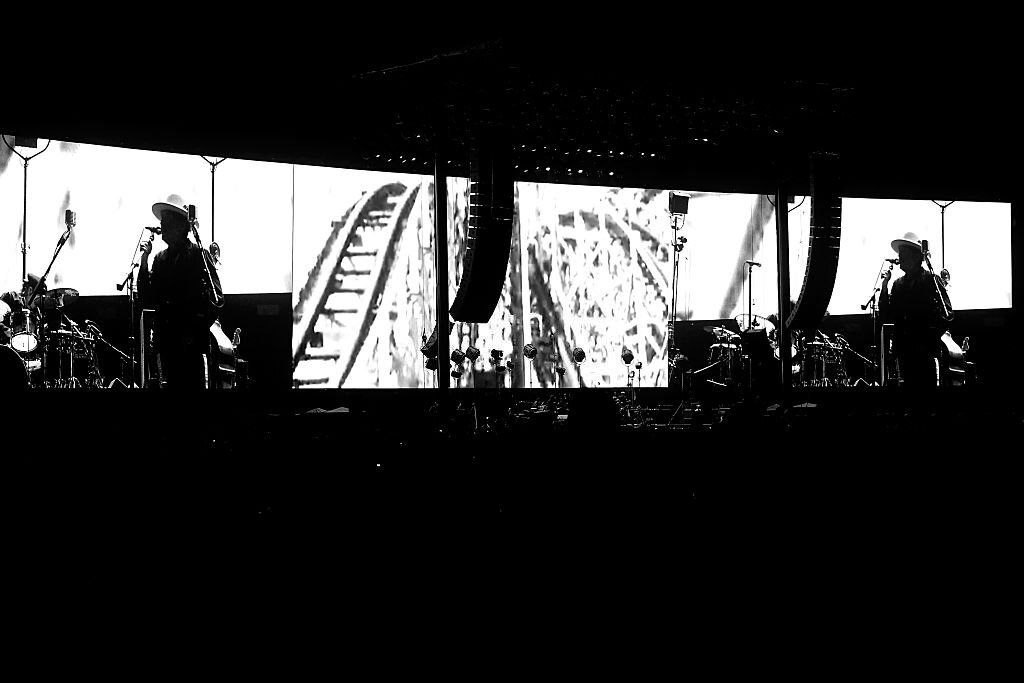Dylan's Desert Trip Film School
2016-10-07, Desert Trip, Indio, CA
Today’s show is a request from Nancy C! Reminder that any Annual subscriber can request a show for me to tackle.

In 2016, Bob Dylan performed two shows at Desert Trip. Better known by the derisive moniker “Oldchella,” the California festival combined six giant acts from the 1960s: The Rolling Stones, Paul McCartney, Roger Waters, The Who, Neil Young, and Dylan. There are perpetual rumor of a ‘70s-focused sequel (eagle-eyed viewers of Springsteen’s 2023 tour dates noted a conspicuous absence of Los Angeles dates…is that why?).
I was reading old reviews of Dylan’s performance. He capitulated more than he sometimes does to the “give us the hits!” feeling of the weekend, digging out some ‘60s songs he wasn’t playing around then, like “Rainy Day Women,” “Highway 61 Revisited,” and “Masters of War” and mostly dropping the Sinatra songs for those two shows.
But one bit in the New York Times review caught my eye, from this paragraph:
Mr. Dylan made few concessions to the festival setting, though he didn’t play a set dominated by Frank Sinatra covers, as he has been on the most recent leg of his current tour. As a rule he refuses permission to be photographed, but early in his set his stage image was enlarged on video screens, the only way for much of the Desert Trip audience to see him. That ended after a half-dozen songs, and scenes from black-and-white movies replaced Mr. Dylan onscreen. Even in the video-laden 21st century, Mr. Dylan was sticking to audio.
It’s the "scenes from black-and-white movies” bit. It’s no secret that Bob never likes blasting his image out to the cheap seats, but I haven’t heard of that happening at other shows. What did that look like? And what movies were the scenes from?
I sought out YouTube videos where you can see that footage projected behind Bbo. Harder to do than I expected, since generally the popular videos have good views of Bob, and I was looking for ones that didn’t, that were taken at a far enough distance to see the full screen behind him. But here’s what I found — and, in a few cases, here’s where the footage comes from.
“Rainy Day Women” starts things off unusually — with Bob performing in front of footage of himself. I don’t mean shots of him standing there onstage; I mean a clips package. 1966 Bob signs autographs, 1975 Bob puts on his Rolling Thunder makeup, etc. There’s even a montage of album covers (uh oh, what intern let 1973’s unauthorized Dylan in there?). That covers montage basically eliminates all his albums after the ‘70s, which tells you you need to know about this festival’s priorities.
But once Bob starts singing, the footage soon transitions to what the Times review described, clips of trains and railways in this case. Skip to the 2:37 mark. See that clip of the train crossing the rising sun? When I sent these videos to Michael G. Smith, a Dylan fan who’s a film professor and director himself (his new feature Relative is screening now!), he identified that bit as coming from a short experimental 1957 documentary called Daybreak Express. And who directed Daybreak Express? None other than D.A. Pennebaker, who eight years later was filming Bob for Don’t Look Back.
Here’s Daybreak Express. You’ll see that very same train shot at 0:27. They clearly slowed it down for the Dylan backdrop.
That’s one movie we (okay, he) identified. We’ll get to a second near the end. But in many other cases, “movies” may be a stretch. A lot of these clips seem to hail from stock footage from yesteryear. I’ll run through the other song videos briefly. Maybe other film buffs will spot the source of one or two more of these clips.
“Don’t Think Twice, It’s All Right” gets, of all things, a volcano exploding. In slow motion:
Keep reading with a 7-day free trial
Subscribe to Flagging Down the Double E's to keep reading this post and get 7 days of free access to the full post archives.
